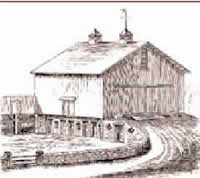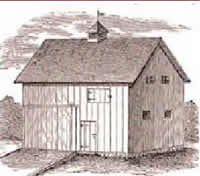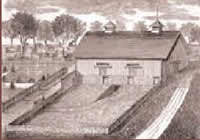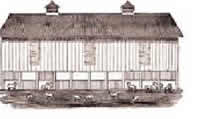|
C.
Jarvis Insurance AgencyINC.
Providing Equine — Liability — Farm and Ranch Insurance
since 1946
Newsletter Volume 1, No. 2• April 2002
Disaster
Planning: Barn Safety
 |
BEFORE:
Plan, Plan, Plan. You never can stop planning ahead for an unknown
disaster. Have a plan in place before the disaster.The plan
can start with a safety inspection of your farm premises. The
inspection should include: |
Electrical systems:
• Are the service boxes in a dry, dust free location and mounted
on fire resistant materials?
• Are the electrical fixtures free of dust, dirt, cob webs,
chaff, hay or combustible materials?
Heating and cooling systems:
• Are they designed for barns and stables?
• Are they installed properly?
Fuel Storage:
• Are the storage tanks located away from buildings at least
40 feet?
• Are the tanks properly grounded?
• Are there fire extinguishers near tanks?
• Are the tanks protected from collision by vehicular traffic?
• Are there clean up protocols for spills?
Are your barns and buildings free of weeds, grass and debris?
• Is the hay cured prior to being stored?
• Are the roofs, walls and windows weather tight?
• Are many fire extinguishers located in every building?
—Are they annually charged?
—Is there 10 pounds ABC or better?
—Are they protected from freezing?
• Is there a phone in all barns with important numbers (fire,
police, key personnel)?
• Are there no smoking signs (is the rule enforced?)
• Are horses valued over $100,000 stabled in separate barns?
Paddock and pastures:
• Are they free of harmful objects?
• Are there no broken planks, exposed nails, sharp or broken
gates?
• Are the horse rotated to break the life cycle of parasites?
|
Stables:
• Are the aisles at least 12 feet wide?
• Are the aisles free of harmful objects?
• Are the stalls latched?
• Are the stalls designed to prevent contact with neighboring
horses?
• Are electrical fixtures (fans, etc.) wiring inaccessible
to horses and properly protected?
• Are the grain and feed rooms locked and containers
covered?
This is not a complete list. It is a start on your way
to a safer environment for your horses.
|
 |
BEFORE A DISASTER:
Survey your property for the best location for animal confinement.
WRITE IT DOWN.
• Alternate water and power sources should be identified. WRITE
IT DOWN.
• Cell phone, portable radios, flashlights, extra batteries,
portable generators are all good sources to have on hand.
• Evacuation plans to relocate (route to fairgrounds, other
farms, race tracks, humane societies).WRITE IT DOWN.
• Alist of all resources - feed, supplies, vets, EMTs, truckers.
Include all emergency telephone numbers (police, fire, hospital
(vet and human, EMT, poison
control). WRITE IT DOWN. Make many copies: this information should
be available at various locations on the farm.
• Have a current list of the horses on the farm or in the stable.
—What paddock and stall they are in?
—Who are the owners or contact persons and what are their telephone
numbers?
— A written procedure on what is to be said to owners/agents
in a disaster?
— Make a script and follow it.
— Records of feeding, vaccinations, Coggins, amount of hay
and feed and what kind given to each animal should be available.
WRITE IT DOWN.
Have a procedure on what animals will be saved in an evacuation
and what animals will be put out to safety.
• Have a job description on who does what.
• Have a phone tree of all key personnel and make sure they
know how to use it.
• Have a drill every quarter in the barn regarding a disaster.
— Who does what? Who calls who?
DON'T PANIC.
• Have emergency kits available in farm trucks and tack rooms.
Emergency kits should have the necessary supplies to treat almost
any kind of minor injury or assist in stopping a major injury from
getting worse. You should have halter shanks, dressings, bandages,
medicines, water buckets, flash lights, radios, etc.
 |
WATER/FEED
• Make sure you have enough water/feed for 72 hours. Secure
it before the disaster occurs. Most horses drink 5 gallons per
1,000 pound weight and 20 pounds of hay.
• Make sure all horses are identified with halters or neck
straps and spray point names on horses left outside to weather
the storm.
• If you evacuate and mark horses make ure you have enough
feed and hay for 48 hours. Call prior to movement to other farms
to make sure the site is still available. Bring the emergency
kit with you.
• If you leave horses behind make sure they have water
and hay for 48 to 72 hours. Leave them in an area that you have
determined appropriate for the disaster situation.
• Make a list of the animals that you evacuate and where
they go. Be sure they are identified.
• Reinforce the emergency training drills you have done
at the farm prior to the disaster.
Plan, Plan, Plan. WRITE IT DOWN. |
DURING A DISASTER
Be calm, don't panic - remember the emergency drill procedures
• Get information from the Emergency Broadcast System. Know
the station. Use a battery operated radio if the power is off.
• If you evacuate and take horses, take all important records,
feeds, etc. Call prior to shipping to make sure emergency location
is still available.
• If you leave horses behind make sure you they are turned
out in a pre-selected area that would be appropriate for the disaster
situation.
• Leave enough hay and water for 48-72 hours. Power may be
lost: a large water tub would be a better choice vs. automatic water.
• Identify all horses with halters and possible splint boots
or bandages with information on the horse inside.

DO NOT PANIC
• Horses will be aware of the disaster by the way you act and
the environment they will be in.
• Call all owners/agents regarding the disaster. Keep them
updated if possible. Use a script or prepared statement when you
call.
AFTER A DISASTER
• Call all owners/agents regarding the disaster, even if there
is no damage to your property.
• Check fencing, pastures and gates for sharp objects.
• Check power lines.
• Be aware of wild animals and snakes. They could be a danger
to you and the horses.
• If horses are lost, contact local farms, veterinarians, humane
societies. Listen to the Emergency Broadcast system for people that
are accepting lost animals.
• Be careful in approaching animals that have gone through
a disaster. They may be frightened and unruly.
• Check with your veterinarian and the Department of Agriculture
for information about possible disease outbreaks.
• Examine all horses after a disaster.
• Check all feed.
• Inventory all horses.
TO SUMMARIZE:
It is very important to plan and have written procedures in place
before the disaster: phone numbers, cellular phones, flashlights,
generators, emergency kits. Have drills every quarter to sharpen
the employees' and owners skills.
JOE CARR
American Bankers Insurance Group
.
|







